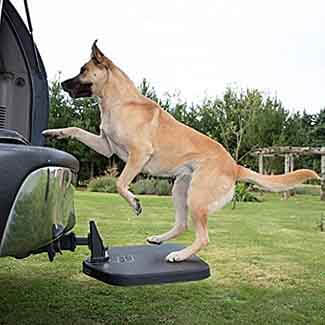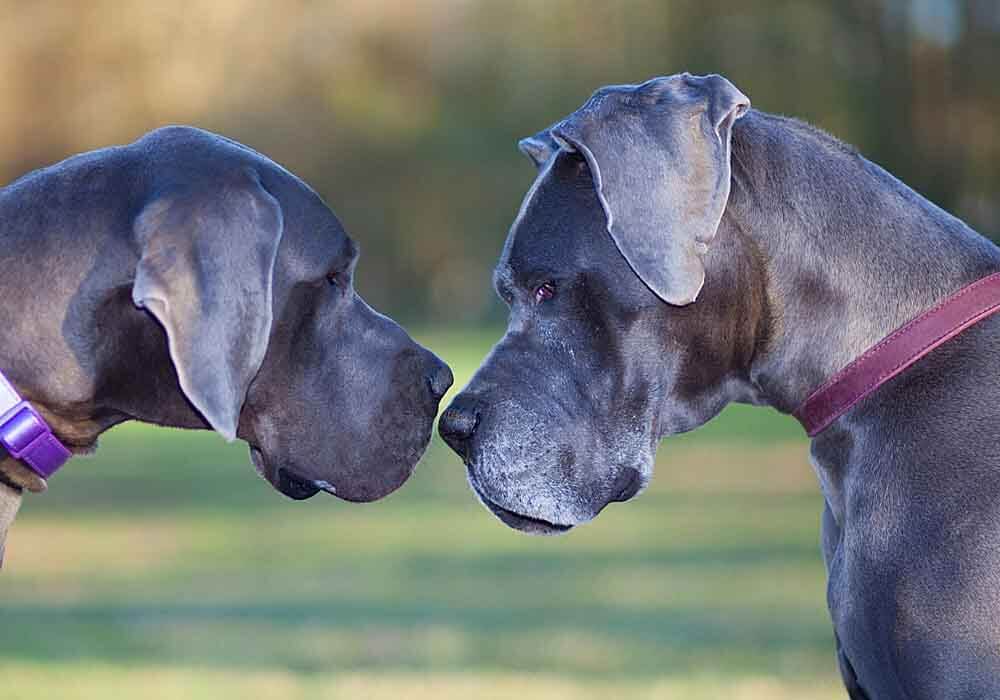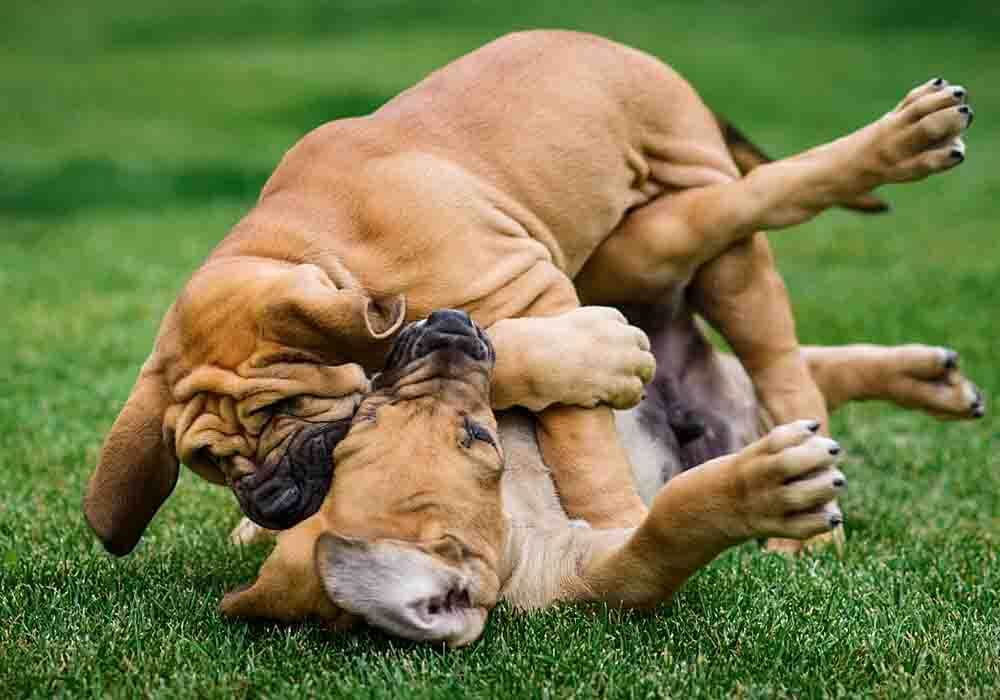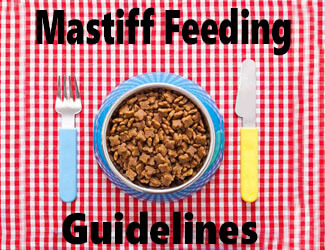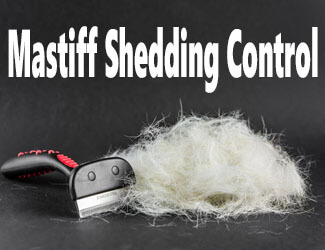Bandog Mastiff
Information
History, Facts, And Temperament
Of The American Bandogge
by Ken Alden
The Bandog Mastiff, also known as the American
Bandogge Mastiff, is usually a hybrid of a Bulldog breed and a Mastiff breed.
Considering its ancestry, it should come as no surprise that the Bandog Mastiff
is an incredible guard dog and loyal companion.
Bandog Mastiff Information And Facts...
- The Bandog Mastiff was created to be the most fierce and alert guard dog out there.
- The breed is known as being “gentle giants” and does fairly well with dogs, cats, and children.
- Bandog Mastiffs are pretty easy to train but can be a tad stubborn.
- Best of all, they just want to spend time with you…and eat
The Bandog Mastiff is a great breed for families, but there’s a lot you need to know about the breed before you bring one home. So, let’s start this Bandog Mastiff information page with the history of the breed.
Pro-tip: Ever try lifting a Mastiff? Their weight can hurt not only your back but their joints when they hop down from cars, sofas or even your bed. To protect your back and theirs check out the best Mastiff ramps on Amazon.com now.
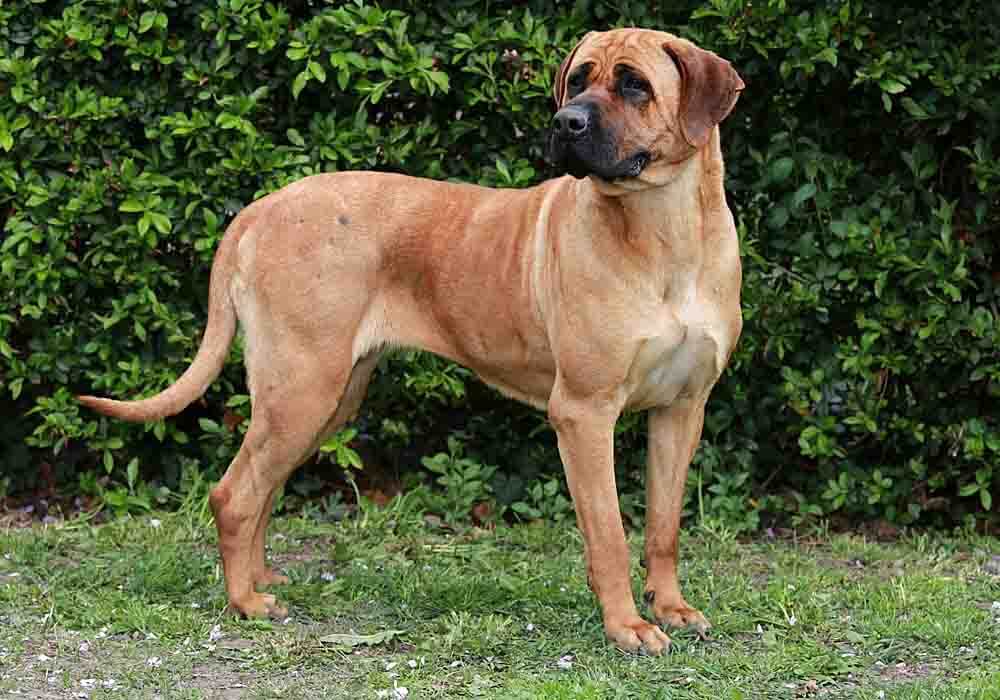
Bandog Mastiff History
What we know as the modern-day Bandog, was first created in the 1960s by a veterinarian by the name of John Swinford. He set out on a mission to create a dog breed so fierce and alert that it would be the perfect guard dog.
The first Bandog Mastiff is believed to be a mix of a Pitbull Terrier and an English Mastiff. Swinford went on to name this new breed, the “Swinford Bandog.” Today, Swinford’s breed has developed and now encompasses several different breeds.
Where the Name “Bandog” Comes From
“Bandog” is actually a term that was used to describe dogs in medieval times who were chained up during daylight hours. When night fell, the owners would detach them from their chains and allow them to roam the property.
The Bandogs of the 1500s and 1600s were
believed to be Bulldog/Mastiff mixes. They were impressively bulky and muscular
and capable of fending off both men and animals.
The Breeds that Make Up the Bandog Mastiff
Today, the breeds that make up the Bandog Mastiff aren’t set in stone. Technically any combination of a Bulldog and a Mastiff could be considered a Bandog, so your pal might look different than somebody else’s.
The most popular combination seems to be a
Neopolitan Mastiff and an American Pitbull Terrier. Though, an English Mastiff
or American Bulldog could be substituted in as well to create the Bandog
Mastiff. bandog mastiff information
Bandog Mastiff Facts
Even though there are no definite answers when it comes to the breeds that make up your Bandog Mastiff, there’s a lot that we do know about this breed. The Bandog Mastiff is a friendly breed, but it’s a bit stubborn and doesn’t take well to submissive owners.
The Bandog Mastiff is extremely loyal to its
own family and will stop at nothing to keep his pack safe. The breed is
relatively quiet and doesn’t bark, even as it’s about to pounce on an
approaching threat. But, the Bandog Mastiff’s reputation precedes it.
They aren’t great “first dogs.”
The Bandog Mastiff typically responds well to new rules and commands. Your Bandog Mastiff will love to please you and will do just about anything to earn a tasty snack.
But, this dog tends to be a little devious and likes to test the boundaries you’ve set in place. He might try to bend the rules and assert his dominance over you.
That’s why this breed needs an assertive owner
that’ll consistently enforce the rules of the house. For that reason, a Bandog
Mastiff would be a better fit for more
experienced dog owners with a little more
confidence.
Pro-tip: Mastiff anxiety, aggression, destructive chewing, jumping up, fearfulness, and other behaviors can be controlled with the right training program.
Here’s a great course that
addresses these issues along with many other dog training basics: Check it out now!
Bandogs Make Great Guard Dogs.
There’s no doubt that the loyalty of this breed is unmatched by any other breed. This innate sense of loyalty and incredible size makes the Bandog Mastiff an incredible guard dog.
Just take a look at the history of the breed,
originally being bred to offer protection and attack strangers and threats.
Your Bandog Mastiff will always be on the hunt, waiting to pounce when he
senses that his family is in danger.
They don’t usually bark.
Remember, the Bandog Mastiff is more of a guard dog than a watchdog. That means he’ll handle the threat himself rather than just alerting you of the danger and waiting for you to take care of it on your own.
The Bandog Mastiff’s approach to being a guard dog is a bit unique. That’s because this breed doesn’t usually bark at threats to scare them off first. No warning barks means your Bandog Mastiff is in immediate attack mode.
They have a rocky reputation.
There’s no doubt that the Bandog Mastiff is an incredible dog breed that thrives in the family setting. Yet, the breed also has a poor reputation as a result of human error.
The first major concern that people seem to have with the Bandog Mastiff is that it was once used as a fighting dog. Even though those days are long gone, the legacy is still attached to the breed and lingers on.
Another issue is that this breed is an ancestor of other fighting and/or sometimes aggressive dogs like the Bulldog, Mastiff, and the Pitbull Terrier. For that reason, the Bandog Mastiff is banned in countries like Switzerland, Romania, and Belarus.
Bandogs are pretty easy to train.
Even though this breed is a little stubborn, training the breed isn’t usually all that difficult. They’re very welcoming of new rules and commands, though it might take a little extra effort to enforce the rules in the long term.
Positive reinforcement will be your best bet when it comes to training your Bandog Mastiff. But, you should also think about early socialization and training through puppy classes to start off on the right foot.
Bandogs drool a bit.
When you mix a Bulldog and a Mastiff, it shouldn’t be surprising that the resulting breed drools. The Bandog Mastiff is much more likely to drool than some other breeds, but there are some ways to control it.
Dogs that drool a lot tend to drool when they have an appetite or when they’re exhausted from playing outside. So, you can set a mat down underneath his food bowl to collect drool as he eats, or you can strap a dog bib around his neck when he comes in from playing outside.
Bandogs are easy to groom.
The Mastiff tends to shed a lot, but the Bandog Mastiff lucked out in terms of coat genetics. The breed is known for having a relatively smooth and thin coat that doesn’t shed all that often.
That means you don’t have to worry about brushing your dog every single day. You’re probably going to be okay brushing him once or twice a week just to remove any excess hair that’s still holding on.
The good Bandog Mastiff information news is, you also don’t have to bathe
the American Bandog all that much. Unless he’s rolling around in the backyard
and getting all wet and muddy, you might be able to get away with only bathing
him a few times a year.
Bandog Mastiff Temperament And Traits
Mastiff and Bulldog breeds both have poor reputations (at no fault of their own), but the Bandog Mastiff’s temperament can speak for itself. If socialized properly, the Bandog Mastiff makes a great family dog, getting along well with dogs, cats, and children.
This breed is loyal and protective of its own brood. Despite its ferocious appearance, this breed is unusually dependent and prefers spending time with its favorite humans. But, the breed does like to test its limits when it comes to the rules of the house.
Bandogs can be Great with Dogs, Cats, and Children
A lot of large breeds struggle with other dogs and cats, but the Bandog Mastiff does surprisingly well. The best way to guarantee a positive relationship would be through early socialization from the day you bring your Bandog Mastiff home from the breeder. bandog mastiff information
Since this breed wasn’t bred to be a hunting dog, their prey drive isn’t unusually high. So, you should be able to get away with having other dogs or cats in the home without issues of aggression.
In terms of children, this dog is truly a gentle giant. Your pal will understand just how large he really is and will play gently and be sweet with children of all ages.
Plus, once he realizes that your children are a part of the family too, he’ll be protective of them as well!
Bandogs are Loyal
As a great guard dog, the Bandog Mastiff will do just about anything to keep you and your family safe. They’re known to immediately attack if they perceive a threat on their pack (you and your family) and truly see you as their master.
In the same realm, you should expect your dog
to be by your side practically 24/7. Even when he’s “off the clock,” he still
wants to be ready and available to you when it’s time to protect you from
danger.
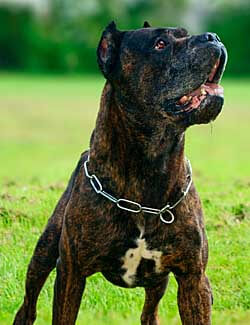
They’re Dependent
Some of the more interesting Bandog Mastiff information we have to share is that despite their large appearance, the Bandog is actually very emotional. Your pooch will absolutely hate to be alone and might even get a little devious or destructive when he’s alone for hours on end.
This dog just wants to spend time with his family and lounge around the house with those he loves. So, don’t be all that surprised if you come home to a wrecked house or urine stains if your Bandog Mastiff has separation anxiety to some extent.
They’re also Stubborn
This breed follows the rules, for the most part! Your Bandog Mastiff definitely knows what’s expected of him in terms of behavior, but he’s going to test his limits to see what exactly he can get away with.
That means you absolutely need to be ready to put him in his place and remind him of the rules. If you let him get away with small infractions, he’ll eventually work his way up to running the house and owning you!
Pro-tip: Mastiff's (and their owners) love dog crates…and for good reasons. Crates keep dogs from mischief while you're away, are perfect for house training, for traveling by car, and provide the dog a place to de-stress. Check out the best Mastiff crates on Amazon.com now.
Bandog Mastiff Height And Weight
The Bandog Mastiff is a pretty hefty dog known for being bulky and muscular. Males typically weigh between 100 pounds (45 kg) and 140 pounds (63 kg) while females are a bit smaller, usually over 85 pounds. The Bandog Mastiff usually measures in at between 20 inches (50 cm) and 30 inches (76 cm) at the shoulders.
With such a big breed, size-related health issues like hip dysplasia and bloat are to be expected. However, they can be prevented by working to keep your dog healthy through a balanced diet and an exercise schedule.
Physical Appearance
You might not be able to identify a Bandog Mastiff by just looking at it. Since this breed can be nearly any combination of Bulldog or Mastiff, they can come in nearly any color, shape, and size!
There have been Bandog Mastiffs that are brindle, white (though it’s rare), fawn, blue, or even a combination of colors.
For the most part, you’ll be able to tell that
a dog is a Bandog Mastiff by its unique build. The dog is very stocky and
muscular (like a Pitbull or a Bulldog), generally has pointy ears, and has
droopy lips (like a Bulldog or a Mastiff).
Bandog Mastiff Health Issues
Because the Bandog Mastiff can weigh up to a whopping 140 pounds, it should come as no surprise that he’s also more likely to develop health issues as a result of his massive size.
Just like other Mastiff breeds, the Bandog Mastiff is particularly prone to joint conditions and even bloat. So, let’s go over what each of these conditions involves.
- Elbow and Hip dysplasia. Larger dogs usually have more body mass, which means excess pressure placed on their joints. With hip and elbow dysplasia, the joints of the legs slowly begin wearing away and grind rather than glide smoothly. As a result, your Bandog Mastiff might hobble around or experience pain.
- Bloat. When large dogs eat too much food in one sitting, they’re filling their stomachs up with a ton of gas and food. When bloat occurs, the stomach actually flips over and traps the build-up of gas. This requires immediate treatment from a veterinarian.
Though you can’t change the size or the genetics of your Bandog Mastiff, there are a few things you can do to keep them healthy in the long-term.
For joint health, it’s best that you give your dog joint supplements that contain Glucosamine and Chondroitin, which both help to repair the joints and keep them flexible. You should also do your best to keep your Bandog Mastiff at a healthy weight for less joint stress.
When it comes to bloat, the best thing you can
do is limit how much you’re feeding your Bandog Mastiff in one sitting. You
should be spreading out his daily food intake into at least two or three meals
a day.
Feeding Your Bandog Mastiff
So, the best method of feeding your Bandog Mastiff involves meal feedings at least twice a day to avoid bloat. But, just how much should you be feeding your dog?
Well, that really comes down to how much your Bandog Mastiff weighs. Here are some general guidelines for feeding your Bandog Mastiff.
- For Bandog Mastiffs less than 100 pounds (45 kg), between 3 and 4 ¼ cups a day should be just fine.
- For Bandog Mastiffs around 100 pounds, feed 4 ¼ cups a day.
- For Bandog Mastiffs over 100 pounds, add an extra ¼ cup for every 10 pounds (4.5 kg) over 100 pounds your dog weighs.
The type of food is also pretty important.
You’re going to want to find a high-quality, high-protein food that’ll keep
your Bandog Mastiff muscular without putting on too much weight.
Bandog Life Expectancy
The average Bandog Mastiff’s life expectancy is about 10 years. However, keep in mind that diet, exercise, and health issues will all play a role in how long your Bandog Mastiff lives.
That’s why you should make it a point to:
- Give your dog 45+ minutes of exercise on a daily basis.
- Feed your dog food based on his weight, not his appetite.
- Provide your dog with joint supplements to prevent joint problems.
The best thing you can do is prioritize your dog’s health. If you notice anything unusual going on with his health, bring him to the vet and have him checked out.
After all, you’d rather catch a disease or
condition sooner rather than later, right?
Bandog Mastiff Information...Conclusion
The Bandog Mastiff is relatively an unheard of dog breed. The breed was first developed in the 1960s as a protective guard dog that would remain loyal and ferocious. Yet, the modern-day Bandog Mastiff is a bit different. Here are some things to know.
- They’re a little stubborn, so they need an owner willing to assert their dominance.
- They love to spend time with their family and hate to be alone.
- They’re prone to some health conditions like hip dysplasia and bloat due to their size.
- They get along great with kids, dogs, and cats.
- They’re the perfect combination of a family dog and a guard dog.
Bandog Mastiff information
Return to the top of this Bandog Mastiff Information page

About the Author...
Ken Alden, a dedicated Mastiff owner for over eight years, is acclaimed for his expertise in care, grooming, and training. Read more About Me and my dog Shadow.
- Mastiff Guide Home ›
- Mastiff Breeds ›
- Bandog Mastiff Information
